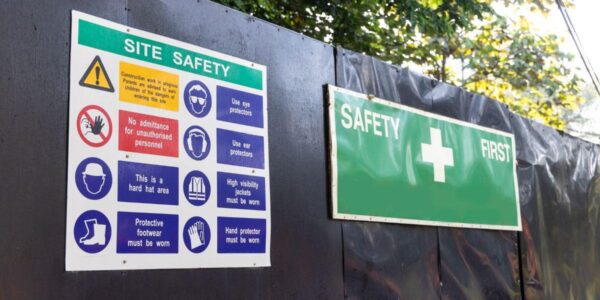
These suggested tasks make the assumption that you are already conducting Toolbox Talks, JHA’s, Site Inspections, tracking Training and Incident Reports. If you are only doing a few of these tasks, you should read 5 Simple Tasks to Improve your Safety Program instead.
Otherwise, it sounds like you are ready to take your safety program to the highest level. Maybe you are the next generation, taking over the family business, and you need to make your mark, or you are looking to really wow your boss this year and nail that promotion.

Whatever your motivation is, here are 5 ways you can join the best in the business as safety rock stars:
1. Create Site Specific Safety Plans
You probably already have a written safety program that covers safety on all your projects from start to finish. A site-specific safety plan takes what you are already using and adds more specific safety measures to it.
You should create one for all major jobs that your crews will be on for an extended period of time and for jobs with unusual hazards your workers are not accustomed to.
In addition to standard project information, the plan should include:
- Location of the nearest hospital
- Emergency contacts
- Name of competently trained person on site
- Hazards specific to the site
- Specific instructions on how to control each hazard
- A list of safety equipment required
- Pictures (general site and specific hazards)
In advance of the project starting, share the plan with the key workers on site so they can put some forethought into it and collect the equipment they will need. On day one of the project, meet with all workers on site to review the plan and do a physical walkthrough. Taking the time to complete these steps will significantly reduce the chance of an incident onsite.
2. Track Near Misses
A near miss is anytime something happens on site that comes very close to causing harm to someone or would have come close if someone was in the vicinity. Here are some examples of near misses:
- Someone trips on an extension cord but does not harm themselves
- A forklift bumps a skid of material; it teeters but does not fall
- A worker drops a hammer down the stairs, but nobody is near
The only difference between these near misses and an incident is luck. Had someone been injured, it would have triggered an investigation into what went wrong and a plan to prevent the incident in the future.
Instead, if you record and investigate near misses the same way you would an incident, you are likely to prevent the incident from happening at all. It’s the same amount of work, just in a proactive manner instead of retroactive.
3. Analyze Safety Findings
If your safety program is fairly advanced, it likely produces a ton of paperwork. That paperwork is likely collected and filed away somewhere, never to be seen again.
This is unfortunate because the information contained in those reports could be the key to safer job sites. If you record the data from these reports into a spreadsheet (or better yet, use a safety management program to do that for you), you are then able to analyze it.
For example, by grouping and categorizing the safety deficiencies found on your site inspections, you’ll be able to find patterns and trends and then apply changes to mitigate them. You’ll figure out if they are caused by specific workers, on certain projects, at certain times, or whether other factors contribute to them.
Using the information you are already collecting instead of filing it away can be one of your biggest assets.
4. Conduct Annual Reviews
At least once a year, look up everything to do with safety for each of your employees on an individual basis and then review it with them. Some items to include are:
- Compliance with your program (Are they doing what they are supposed to?)
- Training Certificates (Are any coming up for renewal? New courses to take?)
- Incidents (Were they involved in any?)
- Infractions (Were they written up at all?)
- Attitude (Do they contribute to a safe company culture?)
- Goals for the next year (What can they work on?)
Some companies go even further to make their reviews live by posting a leaderboard in their shop. A little friendly competition among co-workers doesn’t hurt.
Once you know who your safety rock stars are, you can reward them and provide additional training to the ones who need help.
5. Continue Learning
The construction industry is always changing, and safety changes along with it. It’s important to stay on top of new regulations, new innovations and new ideas.
At the same time, there is a lot of information out there, which can feel overwhelming. We suggest finding a few trusted sources of information and keep up with them.
Here are a few different options:
- Sign up for a newsletter from a local and national trade association
- Bookmark a few reliable construction news websites such as Construction Dive or Occupational Health & Safety
- Find accounts with knowledgeable and free blogs and follow them on social media so you know when new blogs are posted
In short, the more you know, the better, so never stop learning!
You Are Not Alone
What we have just laid out for you would be virtually impossible without help. It’s likely your company has someone on the team dedicated to safety, but even they are going to need help, or they will spend most of their time hovered over spreadsheets and filing paperwork.
If you want to advance to the highest level of safety compliance, you must utilize technology. Using a safety management system is imperative to collecting complete, accurate information in a timely manner. That way, your safety rep has more time to be onsite, where they should be, inspecting, teaching, and making proactive decisions.
There are a number of construction safety management apps on the market, and lucky for you, we’ve summarized them and provided direct links in a super convenient blog post, The 6 Best Construction Safety Apps – Ditch Paperwork Forever.
We’ve also written an article on How Much SafetyHQ Costs, so there are no surprises when you are ready to book a demo to see SafetyHQ in action.
Share Article
Keep on current news in the construction industry. Subscribe to free eNews!



